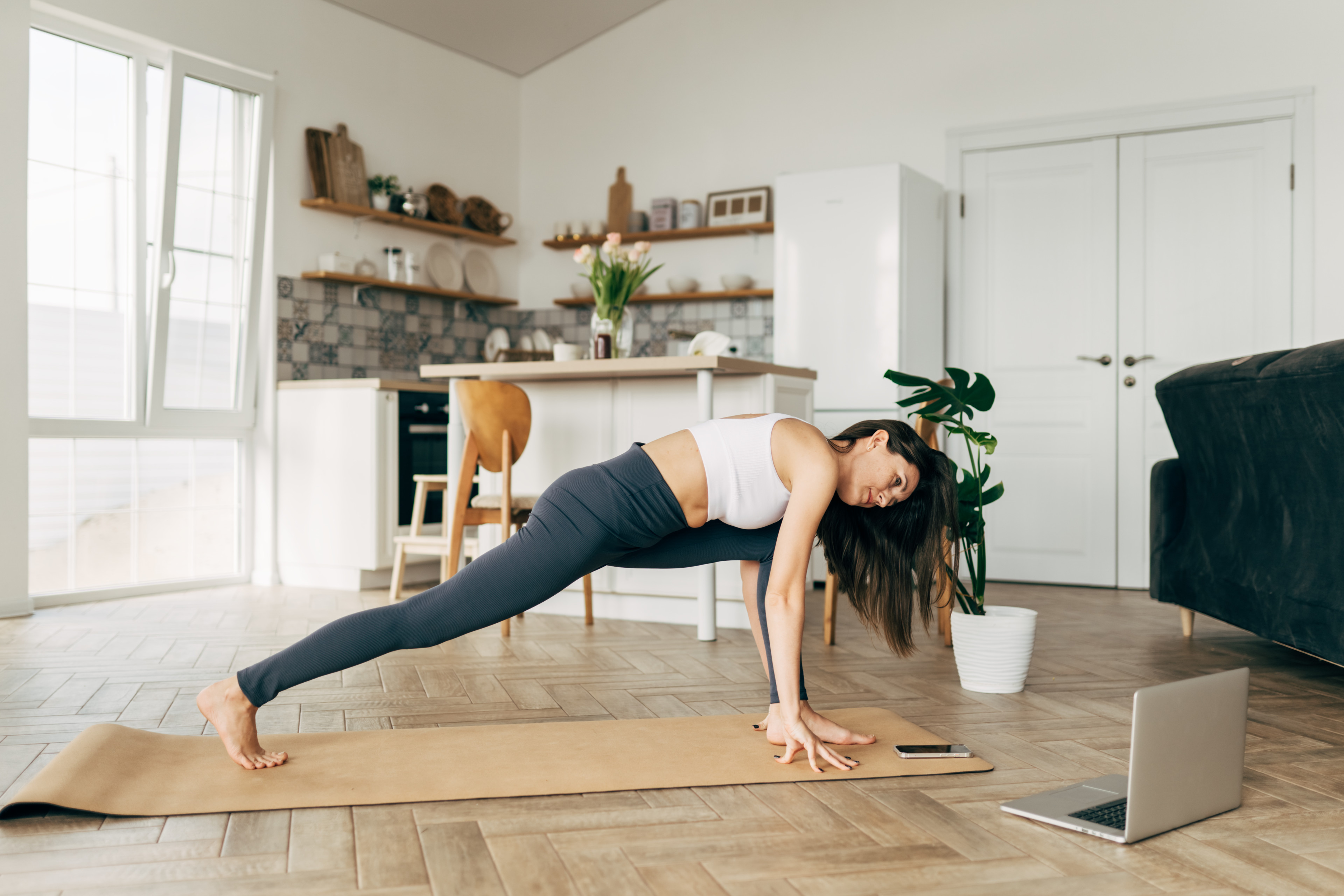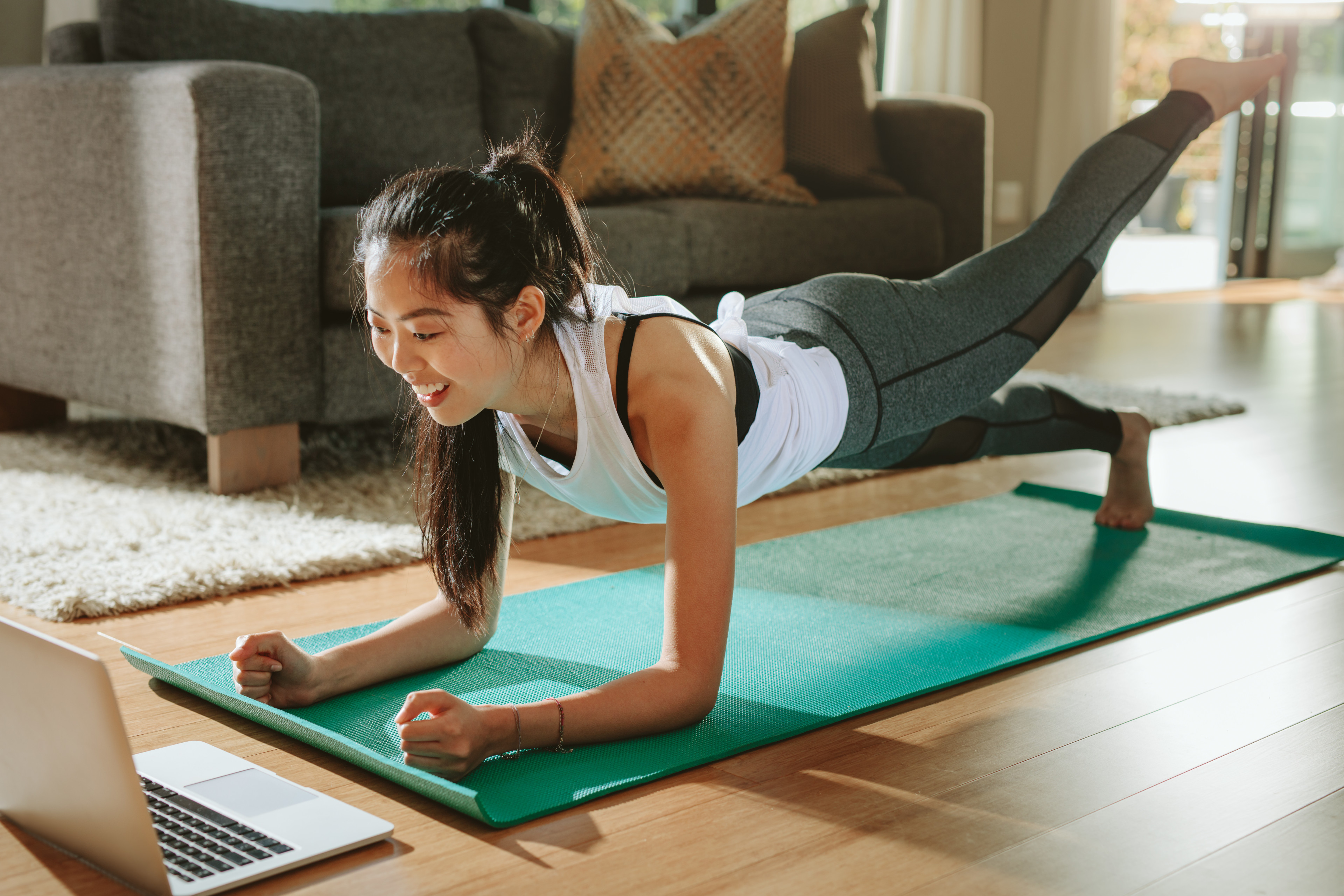
Kseniya Ovchinnikova/Moment via Getty Images
How Often Should You Practice Pilates?
Curious about what you can gain from doing Pilates regularly? Learn about its benefits and how to incorporate it into your workout routine.
By Emily Laurence•
What Is Pilates?
How Often Should You Do Pilates to Experience Results?
How Long Will It Really Take to Notice a Difference In How You Feel From Doing Pilates?
Workouts That Pair Perfectly With Pilates
How to Add Pilates to Your Workout Routine
Walk into any Pilates class and ask people why they’re there and you’ll likely get a wide variety of answers. For some, it’s a form of self-care and stress relief. Others may want to improve their posture. Some may say their goal is to get stronger. Some people practice Pilates because they want to look leaner and have more defined muscles.
Regardless of why you are drawn to Pilates, it’s natural to wonder when you can expect to start experiencing the results. Peloton instructor Anna Greenberg shares what she wants everyone to know about Pilates, including its benefits, how to incorporate it into your workout routine, and when you can expect to start noticing a difference in how you feel.

jacoblund/iStock/Getty Images Plus via Getty Images
What Is Pilates?
First, it’s important to know what Pilates is. Pilates is a combination of repetitive exercises that require muscle exertion. It was created in the early 1920s by Joseph Pilates, who studied yoga, martial arts, meditation, Greek exercises, and Roman exercises. Originally, Pilates was used to help soldiers injured in World War I rehab from injuries, helping their muscles regain strength in a gentle way. But over time, it started being used more widely by others as a way to build muscular strength through gentle movement.
There are six main principles used to get the maximum benefits while doing Pilates: breath, concentration, centering, control, precision, and flow. Typically, a combination of strength and flexibility exercises are done on a mat, using full-body resistance training and work the entire body, including the abdominal muscles, obliques, back, and glutes.
“Pilates has so many benefits. There are so many ways to tailor it to meet whatever body is showing up at whatever season it's in,” Anna says. “Whether you’re a pro-athlete, someone who's coming back from an injury, or someone who's older, there are ways for everyone to practice Pilates and use it to help create balance and harmony within the physical body.”
Besides helping to create balance in the body, Anna says that another benefit of Pilates is that it helps improve posture. Scientific research shows that doing Pilates regularly can help improve spinal deformity and posture. This is because it emphasizes moving the body in a way that centers around optimal alignment, correcting imbalances. “It really takes all the little [muscles and joints] into account and how they fit together and how they can function to their best, which works to bring the body into its optimal alignment,” Anna says.
Another benefit of Pilates is that it strengthens abdominal muscles. “It strengthens the core, which is so much more than an external six pack of abs. It targets the small muscles that connect and helps to create long, lean muscles,” she says.
Work Out Where You Want, When You Want

Peloton App
Access thousands of classes with no equipment needed.
How Often Should You Do Pilates to Experience Results?
Seeing a rundown of everything you can gain from doing Pilates, you may be wondering how often you should do it. Is it safe to do it every day? What should you keep in mind if you’ve never done it before?
Is It Bad to Do Pilates Everyday?
It’s always important to listen to your body and give it the rest it needs, but Anna says that for most people, it is safe to do Pilates every day. “Pilates is a system that can really be tailored to meet you exactly where you are,” she says. “If it's a day where you want to up the intensity, there are so many things you can do. I think as long as you listen to your body and meet yourself where you are, you can practice Pilates as often as you like.”
That means that if you lifted weights the day before and your arm muscles are sore, you can try Pilates moves that focus more on your lower body instead. Or if your hamstrings are tight from a long run, you can do Pilates movements that help stretch your tired muscles, showing them some love and helping them recover.
How Often to Do Pilates As a Beginner
What if you’ve never done Pilates before? Can you still do it every day? Anna says that you can if you want to, but to remember that Pilates comes with a learning curve—just like anything else. “If you've never done Pilates before, I would just keep in mind that it is a very subtle and specific practice,” she says. “Much like yoga, I think Pilates is more so about listening inward. I like to call it a quiet storm, because it's very impactful, but it's not very loud. You might not get very sweaty. You might not feel initially like you did something really big, but that doesn't mean that you didn't do something very impactful. So I would just keep that in mind and stay with it.”
Anna adds that if you’re new to Pilates, it’s also important to give yourself grace. It isn’t easy to try something new! “If it feels like you're getting things wrong or it's confusing, just give it time. Stay with it and trust the process,” she says.
How Long Will It Really Take to Notice a Difference In How You Feel From Doing Pilates?
If you really want to notice a difference in how you feel from doing Pilates, Anna recommends doing it at least three times a week. “For anything that you're starting to build a real impactful relationship with, three times a week is a good place to start to really commit and to be able to feel and see your progress,” she says.
Maybe you are wondering when you can expect to feel stronger and have more defined muscles. If these relate to your health goals, Anna recommends committing to doing Pilates at least three times a week for a few months. In terms of when you will notice a difference in how you feel, Anna says there isn’t one timeline that works for everyone. After all, it depends on what one’s starting point is and what their other habits are, including how else they move their body and what their eating habits are like.
Workouts That Pair Perfectly With Pilates
Every form of exercise brings their own unique benefits to the table and Pilates is no different. While it’s beneficial in many ways, there are some other forms of exercise that support the body in ways Pilates isn’t meant to. For this reason, it can help to pair your Pilates practice with another form of exercise. The types of exercises outlined below work well in tandem with doing Pilates regularly without over-stressing the body.
Running or Cycling
While Pilates is a great form of exercise for strengthening muscles, it doesn’t raise heart rate as much as cardio-based exercises such as running or cycling. For this reason, it can be beneficial to pair Pilates with a form of cardio you enjoy. Anna says that a benefit of pairing them together is that cardio can improve stamina and heart health more than doing Pilates without a form of cardio.
Here’s what’s really cool: Anna says that doing Pilates regularly will actually help you become a better runner or cyclist. “It can help improve your breathing, which can give you greater capacity to run and cycle further faster with more power. It’s a beautiful relationship,” she says.
Weight Training
If your health goal is to build muscle, Anna recommends pairing Pilates with weight training since you can add more resistance with heavier weights. You can do weight training with equipment such as dumbbells, weight machines, or kettlebells, to name a few examples. Lifting weights is also important for preserving muscle loss while losing weight and for keeping bones strong.
Yoga
While yoga and Pilates are similar in the way that they use gentle movement to build strength, yoga incorporates a spiritual practice that Pilates doesn’t. With this in mind, if you want to incorporate a form of exercise into your routine that focuses more on mindfulness and turning inward, yoga is a great workout to do in addition to Pilates.
How to Add Pilates to Your Workout Routine
It is safe to do Pilates every day, but you certainly don’t have to in order to experience its benefits; three times a week is enough. Not sure where to start? Try one of Peloton's Pilates workouts, which range from 20 to 45 minutes. That way, you can incorporate it into your routine depending on how much time you have that day.
As mentioned earlier, it’s also beneficial to pair Pilates with another form of exercise, such as cardio, weight lifting, or yoga. You can do one of these forms of exercise the same day as Pilates or on different days, depending on what works best for your schedule and how your body feels.
Clearly there is a lot to gain from doing Pilates regularly. Commit to doing it multiple times a week for a few months and you’re bound to see both your strength and posture improve.
This content is for informational and educational purposes only and does not constitute individualized advice. It is not intended to replace professional medical evaluation, diagnosis, or treatment. Seek the advice of your physician for questions you may have regarding your health or a medical condition. If you are having a medical emergency, call your physician or 911 immediately.
Level up your inbox.
Subscribe for a weekly dose of fitness, plus the latest promos, launches, and events.
By providing your email address, you agree to receive marketing communications from Peloton.
For more about how we use your information, see our Privacy Policy.





